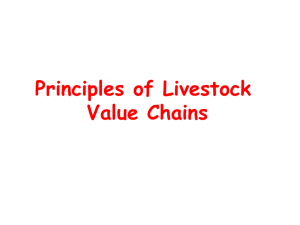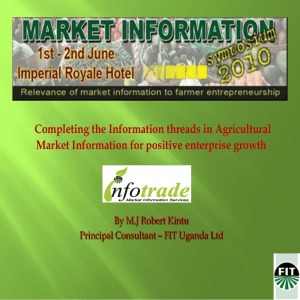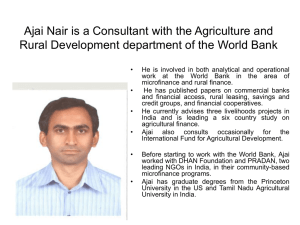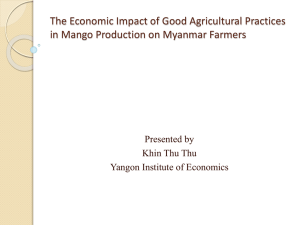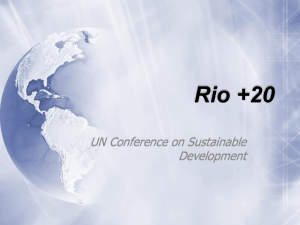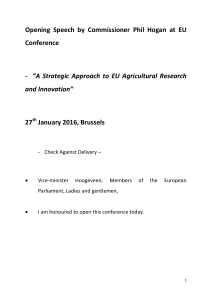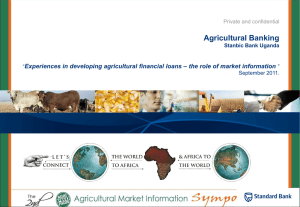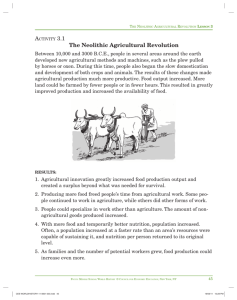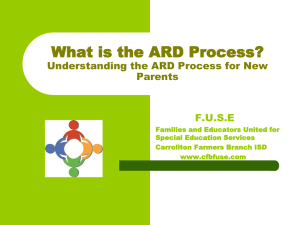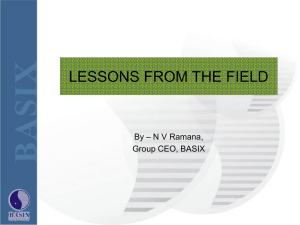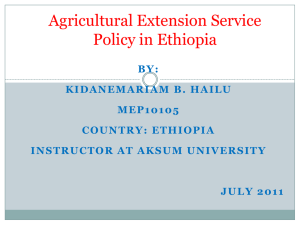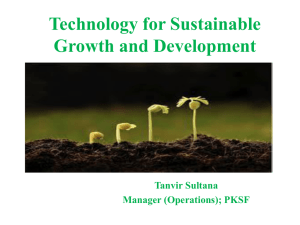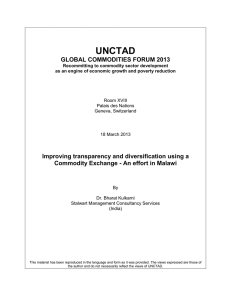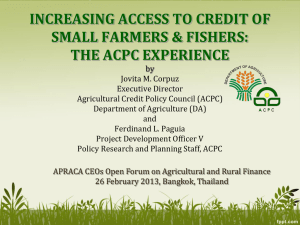The Concept of Innovation Platform for ARD
advertisement
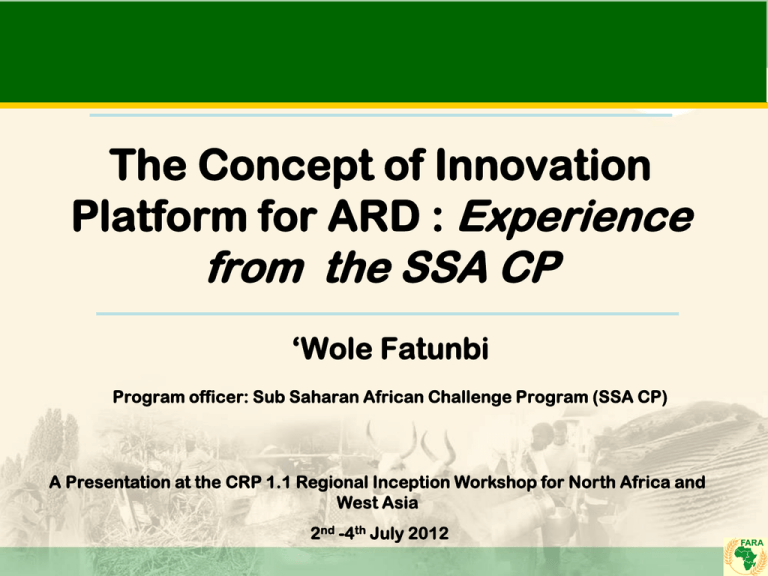
The Concept of Innovation Platform for ARD : Experience from the SSA CP ‘Wole Fatunbi Program officer: Sub Saharan African Challenge Program (SSA CP) A Presentation at the CRP 1.1 Regional Inception Workshop for North Africa and West Asia 2nd -4th July 2012 Outline Purpose To explain the Innovation Platform and its partnership arrangement that yields the desired Innovation African ARD has had numerous successes However, the impact of the technologies did not match their potentials • Institutional setting of the research system can not support scaling up of the technologies. • Approaches to R&D is not all encompassing. • Inadequate human and financial resources Technologies being hindered by institutional barriers Alter the landscape for changes to take place A (+) B (-) Differences in the system Reflecting of Evolution of ARD systems scenarios ARD System Scenario yes No No No No No No Value chain consider ation No Yes No Yes No No No No No No Yes Yes Yes No No No No No Yes Yes Yes Yes No No No No No No Yes No Yes No No No yes yes No yes Yes No No yes yes No No No No No No No Yes No No No No Yes Yes Yes No yes yes Yes Yes Yes No Yes Yes No No Yes No No Yes No yes Yes No No Yes No No Yes Research Traditional linear model for research and extension Farming systems perspective (OFR/FSP Participation/participatory research methods Action research Rural livelihoods Agri-food systems/value chain Positive deviance Knowledge development, dissemination and use Doubly green revolution Rainbow revolution IAR4D Partners engagement Extension Farmer Policy Private End user Market considera tion Research demanded by Users No About IAR4D ? IAR4D is designed to overcome the shortcomings of thea multi-sectorial, traditional R&D IAR4D concept entails multistakeholders systems. orientation to agricultural problem diagnosis, and draws on integrated approaches using ‘hard’ . and ‘soft’ sciences to provide solutions, while maximizing the available resources IAR4D is premised on the innovation systems approach and requires systemic interaction among all stakeholders around specific commodity or production system. What is an Innovation Platform ? An Innovation Platform is a physical or virtual forum established to facilitate interactions, and learning among stakeholders selected from a commodity chain analysis Their interaction leads to participatory diagnosis of problems; joint exploration of opportunities and investigation of solutions leading to the generation of agricultural innovation along the targeted commodity chain IAR4D - Participation and Gainful Interaction Farmers Policy Private Sector End users Innovation Systems Extension Transpoters Research Output categories from the Research Action Innovation Platform •Research Themes Productivity Natural Resource management Market Policy Product Development Nutrition •Gender Technological Innovation Institutional Innovation Infrastructural Innovation Socio-economic Benefits Peculiarities of IAR4D Concept A. IAR4D simultaneously addresses research and development as a fused continuum for generation of innovation. B. All stakeholders in an IP have a contribution and benefits which sustain their interest and continued participation C. Innovation generated using IAR4D will benefit all stakeholders on the platform. D. IAR4D engages the policy makers at different levels all along the process of R&D till innovation is generated. E. IAR4D ensures a smooth public-private partnership in ARD. How to set up an Innovation Platform and Its Relevance to CRP 1.1 in NA&WA The IP establishment Process in SSA CP Site Selection: Identification of opportunities, challenges in agricultural productivity Selecting Commodities / Production Systems: Commodity analysis – opportunities and constraints The IP Selecting Partners: Value chain analysis for the commodity Stakeholder analysis using multiplicity of frameworks From production to consumption- farmers (groups) , inputs (seeds, fertilizer, agrochemicals, finance and insurance) and including Policy and agro- meteorologists. The IP Mobilizing the members: • Start from the end- what market? • Who produces- how many farmers and hectares • How many extension officers can serve them adequately? • What quantity of seeds required and who provides these? • What quantity of fertilizer and other agrochemicals and who provides these ? The IP Mobilizing the members contd: How much money is required and which bank provides this? What other services are required- processing, bulking, transportation? Policy makers are invited Meteorology also invited Stakeholder analysis for determination of capacity strengthening needs to meet market demand What is needed; who provides, it and what methodology Farmers’ training largely provided by the Extension and geared towards production to meet market demand Managing Partnerships on an IP 1. Develop management and governance guidelines 2. Facilitation of interaction of stakeholders. 3. Development of business plan 4. Implementation of business plans 5. Establishment of PM&E measures to draw lessons 6. Review of implementation and lesson learning including review of business plan in response to lessons and re-assessment of priorities. Product Development & Market Innovation Success story…. Uganda Mamera now in the supermarket • Through Mamera drink, 5000 farmers increased their income by an average 80% in Productof of indigenous knowledge strengthened Uganda with modern science and • Kasiksi drink contributions fromdeveloped the University of Makerereof at the University willing entrepreneurs Goma in DRC increased Producers looking for themarket income of 2500 Input dealers looking for banana farmers by an market Cooperation of Policyin DRC average of 200% makers and extension Stanbic Bank Win-Win Partnerships Potato packaging in Rwanda Introduction of new packaging of potatoes doubled the income of 2000 farmers from USD 0.2/kg to USD 0.4/kg per farmer, with each farmer making an additional average profit of USD 1,600 per season from potato production. Implication of CRP 1.1 Methods in NA&WA 1. The need to train and create space for IP facilitation in program implementation. 2. Change of mindset to work with other stakeholders in a business mode. 3. Advance research endeavor beyond the point of knowledge and technology generation to the point where innovation is generated. 4. Need to work with system perspective, and allow a blend of different forms of interventions. Conclusion • IAR4D provides a holistic approach to solving the problems of agricultural research in Africa. • IAR4D concept is implemented through the innovation platform. • Innovations are generated at the interface of the interaction of all stakeholders along the commodity value chain on the IP. • The adoption of IAR4D concept is fast spreading among ARD stakeholders and countries in Africa. Relevant SSA CP reports Supportive Journal Articles Adekunle A.A and Fatunbi A.O (2012). Approaches for Setting-up Multi-Stakeholder Platforms for Agricultural Research and Development. World Applied Sciences Journal 16 (7): 981988, 20. Kefasi Nyikahadzoi, Fatunbi A.O, Olarinde L.O, Njuki J and Adekunle A.A (2011). Stakeholder Participation in Innovation Platform and Implications for Integrated Agricultural Research for Development (IAR4D). International Journal of Agriculture and Forestry Vol 1(1): 1-9 Nyikahadzoi Kefasi, Fatunbi Oluwole, Adekunle Adewale and Odularu Gbadebo (2011). Promoting effective multi-stakeholder partnership for policy development for smallholder farming systems: A case from the Sub Saharan Africa challenge program. African Journal of Agricultural Research Vol. 6(15), pp. 3451-3455, Thank you 37

